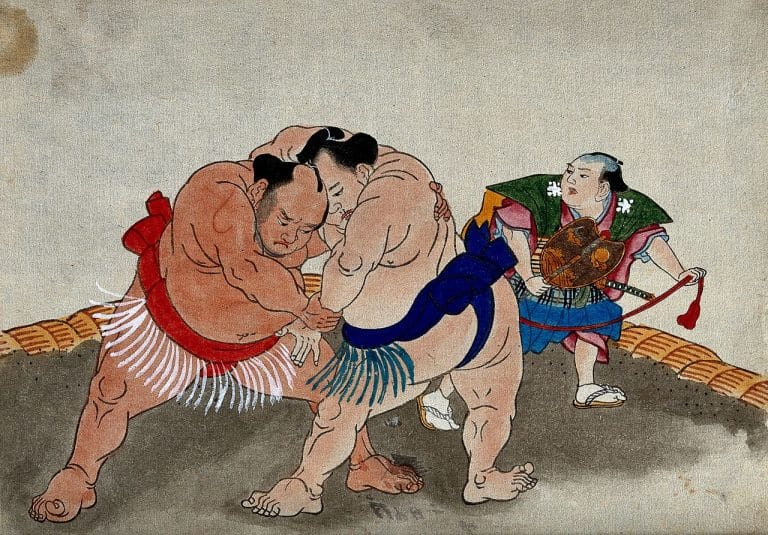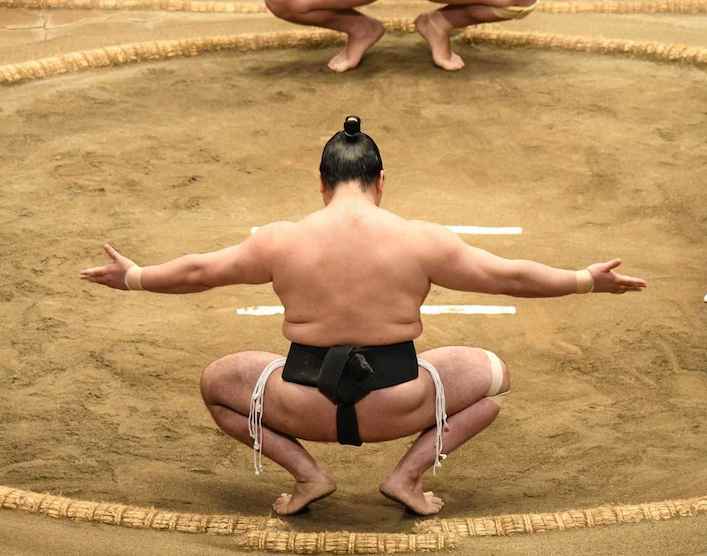Sumo wrestling is a Japanese sport that has gained popularity worldwide. It involves two wrestlers, or rikishi, who attempt to push their opponent outside a circular ring or force them to touch the ground with any part of their body other than their feet. This traditional sport is deeply rooted in Japanese culture and has a rich history that dates back centuries. Understanding its history is crucial in appreciating the sport’s significance.

Learning about the history of sumo wrestling can enlighten us about Japanese culture, traditions, and values. It can also give us an insight into the evolution of the sport and how it has changed over the years. This fascinating sport has survived natural calamities, wars, and political changes and continues to evolve to this day.
This blog post aims to provide a deep dive into the history of sumo wrestling. We will explore the origins of the sport, its early development, and its place in Japanese culture. We will also examine the role of sumo wrestling in modern society, its popularity worldwide, and its impact on international sports. So sit back, relax, and join us for a journey through the fascinating history of sumo wrestling.
Origins of Sumo Wrestling
Sumo wrestling’s origins are debatable, with some suggesting its roots lie in China’s Tang dynasty’s wrestling practice. However, it gained prominence in Japan during the Nara period, serving as an imperial diversion. Introduced around 1600 years ago as a Shinto ritual, sumo wrestling steadily evolved into a national spectacle, particularly in the Edo period. This era saw matches fundraise for temples and shrines, celebrating winning wrestlers as local heroes. Royal and aristocratic attendance boosted sumo’s national sport status.
Unlike today’s sumo, Edo period sumo was less structured. The Meiji period saw its modernization, officially recognizing it as a sport with regulatory rules. Matches then took place in formal arenas, with athletes wearing a traditional mawashi.
Contemporary tournaments consist of six matches held over several days. The wrestler winning most bouts receives the championship title. Despite significant changes, modern sumo remains culturally significant and popular within Japanese sports culture.
Sumo is currently seeing a resurgence with increasing numbers of foreign wrestlers. The path to professional wrestling involves training under a professional stable, living within the stable, and undergoing rigorous training under professionals’ guidance.
In essence, sumo wrestling’s rich history reflects Japanese culture profoundly. Although its origins are uncertain, it’s believed to have arrived in Japan over a millennium ago. Despite extensive changes, sumo maintains cultural significance and strong roots in Japanese sports culture.
Read: Sumo Wrestling’s Impact on Japanese Culture
Early Rules and Traditions
- During the Edo period, there were strict rules and regulations for sumo wrestling matches.
- The wrestlers were not allowed to wear any clothing, except for a loincloth, known as a mawashi.
- Matches were held on an elevated ring, or dohyo, made out of clay and straw.
- Before the match, the wrestlers would perform a ritual called shiko, which involved stomping their feet.
- If a wrestler touched the ground outside of the dohyo with any part of their body, they would lose.
Sumo wrestling was not only a sport during the Edo period, it was also a form of entertainment that was enjoyed by the upper and lower classes. Sumo wrestlers were celebrities and cultural icons, often appearing in art pieces, literature, and even theater productions.
The sport of sumo wrestling also had symbolic significance, with various rituals and traditions associated with it. One such tradition is the use of salt by the wrestlers before the match. The salt is used to purify the ring and ward off evil spirits.
- Another symbolic tradition is the use of the gyoji, or referee.
- The gyoji wears a colorful robe and performs specific rituals throughout the match.
- After each match, the wrestlers perform a ceremony called yumitori-shiki, where they use a wooden bow to brush off the dirt from their bodies.
Sumo wrestling holds a sacred spot in Japanese religion, originally staged to entertain the gods. Its ties to Shintoism endure, with a dedicated shrine in Tokyo’s Ryogoku district. Early rules and traditions have molded the sport, influencing regulations during the Edo period and fostering symbolic rituals. This has cemented sumo wrestling’s place in Japanese culture.
Read: What are the Basic Rules of Sumo Wrestling?
Modernization and Changes
Sumo wrestling has undergone numerous changes and modernization over the years, shaping the sport into what it is today.
Reforms in the Meiji period
In the late 19th century, Japan’s Meiji government sought to modernize the country and reform traditional practices. Sumo was no exception, and the government implemented various changes to the sport.
Innovative Tech Solutions, Tailored for You
Our leading tech firm crafts custom software, web & mobile apps, designed with your unique needs in mind. Elevate your business with cutting-edge solutions no one else can offer.
Start Now- Sumo wrestlers were required to wear silk uniforms instead of loincloths, which were considered outdated.
- The dohyō, or ring, was standardized to a size of 4.55 meters in diameter.
- The kimarite, or winning techniques, became standardized and increased in number from 48 to 82.
- Matches were no longer allowed to end in a draw, and judges were introduced to determine the winner.
Introduction of weight classes and tournaments
Sumo wrestling continued to evolve throughout the 20th century, with new changes being introduced to make the sport more competitive and exciting. One of the most significant changes was the introduction of weight classes, which allowed for fairer matches between wrestlers of different sizes.
- In 1927, a 6-tier weight classification system was established, ranging from under 60 kg to over 115 kg.
- Later, in 1958, the system was expanded to include a top division called makuuchi, which consisted of the heaviest and most skilled wrestlers.
- Along with weight classes, tournaments were introduced to the sport. The first official sumo tournament, or basho, was held in Tokyo in 1926.
- Today, there are six annual tournaments held in various locations throughout Japan.
Doping scandals and controversies
Like many professional sports, sumo wrestling has had its fair share of scandals and controversies over the years. One of the most significant issues facing the sport today is the use of performance-enhancing drugs.
- Several high-profile wrestlers have been caught using illegal substances, leading to lengthy suspensions and even criminal charges.
- In 2008, it was revealed that top-ranked wrestler Asashōryū had assaulted a man outside a Tokyo nightclub, leading to his retirement from the sport.
- Controversies have also arisen over the sport’s treatment of women. Female sumo wrestlers are not allowed to compete professionally, and there have been calls for greater gender equality in the sport.
Despite these challenges, sumo wrestling remains a beloved and iconic part of Japanese culture. Its rich history and traditions continue to inspire generations of fans and wrestlers alike.

Famous Sumo Wrestlers
Sumo wrestling has produced some of the most iconic sports figures in Japanese history. Here are some of the most famous sumo wrestlers:
- Raiden Tameimon: Known for his massive size and strength, Raiden Tameimon was one of the most dominant sumo wrestlers of the late Edo period.
- Tanikaze Kajinosuke: Tanikaze was a legendary sumo wrestler who was known for his fierce spirit in the ring. He amassed a record of 47 wins and no losses during his career.
- Akebono Taro: Akebono was the first foreign-born wrestler to reach the rank of yokozuna, the highest rank in sumo wrestling. He won 11 championships in his career.
- Hakuho Sho: Hakuho is widely considered one of the greatest sumo wrestlers of all time. He has won a record-breaking 44 championships and has held the rank of yokozuna since 2007.
Raiden Tameimon and Tanikaze Kajinosuke, classic wrestlers, founded the sport’s traditions and techniques. Modern wrestlers like Akebono Taro and Hakuho Sho brought fresh athleticism and increased popularity.
Akebono Taro gained fame by showcasing sumo wrestling to the west. He appeared on American talk shows and participated in mixed martial arts fights. He extended sumo’s reach, inspiring aspiring wrestlers globally.
Hakuho Sho stands as a national hero in Japan due to his dominance in the sport. His technique, strength, and humility earn him praises in and out of the ring. He symbolizes Japan’s rich sumo heritage, serving as a role model for the country’s youth.
The immeasurable impact of these sumo wrestlers on the sport defines Japan’s traditions and culture. They inspire future generations, and their legacies will continue shaping sumo wrestling for years to come.
Misconceptions about Sumo Wrestling
Sumo wrestling, being a relatively unfamiliar sport to many, has garnered a few misconceptions. To clear things up, here are some of the common misconceptions surrounding sumo wrestling:
Common misconceptions about the sport
- Sumo wrestlers are overweight and unhealthy.
- It’s just about pushing the other guy out of the circle.
- Sumo is just a glorified fat man’s wrestling.
- Sumo is a violent sport where athletes get injured frequently.
While some of these may seem true at first glance, they are actually not.
Addressing these misconceptions and clearing up misunderstandings
Firstly, sumo wrestlers are not just overweight, they are athletes who have trained for many years to reach their current form. They have strict diets and training regimes to maintain their physique.
Secondly, sumo wrestling is not just about pushing the other guy out of the circle. It is an ancient Japanese sport that is rooted in tradition, respect and discipline. In fact, there are many complex techniques and strategies involved in the sport which require a great deal of skill and training.
Thirdly, sumo is not just a glorified fat man’s wrestling. The sport has a rich cultural history and is deeply rooted in traditional Japanese values. It is a sport that requires discipline, mental focus, and respect for one’s opponent.
Lastly, while injuries do happen in sumo wrestling, they are not as frequent as one may think. Sumo wrestlers are trained to fall properly, and many injuries come from training rather than actual matches.
Emphasis on respect and discipline in the sport
One of the most important things to understand about sumo wrestling is the emphasis on respect and discipline. Before every bout, the wrestlers perform intricate rituals that showcase mutual respect and show reverence for the sport. In addition, the sport has a strict code of conduct that all wrestlers must follow, such as wearing a traditional silk mawashi and adhering to a strict diet and training regimen.
Sumo wrestling is not just a physical sport; it is a sport that requires mental and emotional strength as well. Wrestlers must be able to stay calm under pressure and maintain focus during intense matches. They must also be able to handle defeats with dignity and respect for their opponents.
Sumo wrestling may have many misconceptions surrounding it, but the truth is that it is a traditional, rich and deeply respected sport that requires a great deal of skill, discipline, and respect. By understanding the true nature of the sport, we can appreciate the centuries-old tradition and cultural significance of sumo wrestling.
Conclusion
Sumo Wrestling has a long and fascinating history, dating back to ancient Japan. It has evolved over the centuries and continues to be a significant part of Japanese culture and heritage.
We explored the origins of Sumo, the development of the sport throughout history, and the traditions and rituals that surround it.
It is crucial to preserve the history and traditions of Sumo Wrestling, not only for the benefit of Japanese culture but also for sports enthusiasts worldwide. The sport has become a symbol of national pride and is a vital part of Japan’s identity.
As we look to the future, Sumo Wrestling continues to evolve and attract new fans worldwide. Its lasting legacy and cultural significance make it a treasured part of Japanese history and tradition.
In conclusion, Sumo Wrestling is more than just a sport. It is a reflection of Japanese traditions and values that have been passed down through generations. As the sport continues to thrive, it is essential to honor its rich history and preserve its cultural significance for generations to come.
Read: Best Strategies to Negotiate Your Pay as a Footballer
Before You Go…
Hey, thank you for reading this blog to the end. I hope it was helpful. Let me tell you a little bit about Nicholas Idoko Technologies. We help businesses and companies build an online presence by developing web, mobile, desktop, and blockchain applications.
Seamless API Connectivity for Next-Level Integration
Unlock limitless possibilities by connecting your systems with a custom API built to perform flawlessly. Stand apart with our solutions that others simply can’t offer.
Get StartedWe also help aspiring software developers and programmers learn the skills they need to have a successful career. Take your first step to becoming a programming boss by joining our Learn To Code academy today!
Be sure to contact us if you need more information or have any questions! We are readily available.











